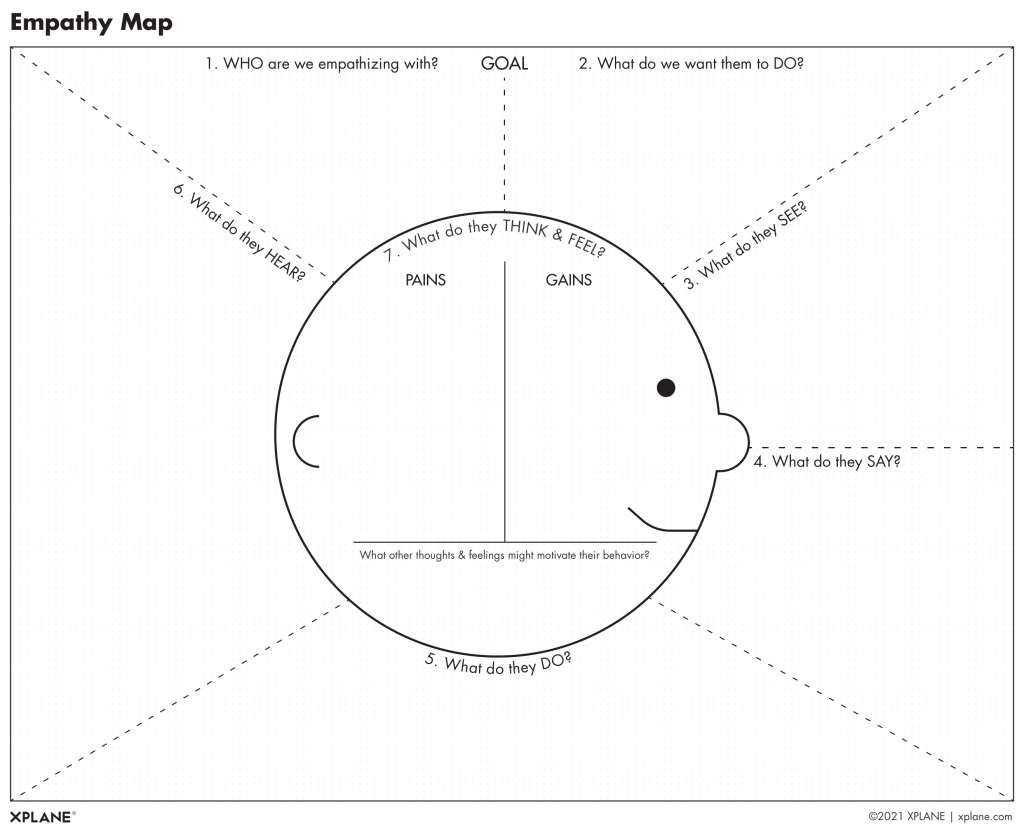Empathy has been frequently discussed in recent years, especially in the corporate world.
You’ve probably heard someone saying — whether in your company, at home, on TV, or the Internet — that “we need to be more empathetic with each other.”
But what does this mean in practice, and where does the Empathy Map come into play?
Empathy refers to the ability to put yourself in another’s shoes, understanding the feeling or reaction of an individual by imagining yourself in the same circumstances and/or context.
Exercising empathy makes it possible to improve relationships because it grows your knowledge about someone else and reduces conflicts.
It also leads to fairer and more sympathetic discussions.
In the business context, imagine truly understanding what is going on in your customer’s head, realizing what problems they face and what they need to succeed.
The Empathy Map is a tool that makes this possible, putting the company — or the brand, advertising agency, or whoever wants to know about the target audience — in the customer’s shoes.
In this article, you will understand the Empathy Map and how to use it in your agency or Digital Marketing department. We will cover:
- What is the Empathy Map?
- Why Use the Empathy Map?
- How to Fill out an Empathy Map in 7 Steps?
- What Would a Complete Empathy Map look Like?
- What Benefits does the Empathy Map bring to the Marketing Strategy?
- What are the Best Tips to Have a Good Empathy Map?
- Wrap Up: The Empathy Map is a Vital Tool
Download this post by entering your email below
What is the Empathy Map?
Developed by XPLANE, an international design thinking consulting firm, the Empathy Map is a visual management tool that allows you to deeply know your customer through a diagram that establishes questions and topics about different areas of a persona’s life.
You can perform it on a blackboard by adding post-its, flip charts, sulfite paper, or a computer.
The exercise consists of reproducing the business customer in a visual format, enabling the collection of hypotheses about the selected target audience and the team’s understanding of the consumer’s reality.
The map is then enriched as the team answers questions about the customer, such as who they are, what they see, what they listen to, what they say and do, what they think and feel, and what their pains and needs are.

What’s the goal of the Empathy Map?
The goal is to achieve a deeper level of understanding of the persona, which could be a customer, prospect, partner, and so on.
Ideally, the Empathy Map should be drawn after clearly defining the personas, as this will provide an in-depth analysis of the customer.
However, even if you don’t understand the client very well, the exercise of empathy mapping can help you identify gaps in your understanding and obtain a more profound knowledge of things you don’t quite know yet.
➤ Within an agency, Service, Planning, and Digital Marketing teams can benefit from the tool.
➤ A brand can use the Empathy Map to understand its consumer better and thereby optimize marketing strategies.
➤ In a marketing department or in-house agency, it can be used by the marketing team to understand the persona of the organization or institution and, consequently, enhance advertising campaigns.
How does the Empathy Map relate to the concept of persona?
The buyer persona is a fundamental marketing concept.
It helps brands to better understand how their audience behaves and what their needs, desires, and demands are.
Naturally, a series of details such as personality, buying habits, socioeconomic status, and age impact the way they consume.
The persona is a very precise tool to help evaluate all these characteristics and draw a model of the brand’s audience. Research and studies are used to help us figure out all of these points.
This way, the persona is a fictitious profile that represents the behavioral pattern of that brand’s consumer.
This base model makes it possible to develop campaigns, actions, and products that are more likely to please the public.
The Empathy Map provides a more thorough detailing of the persona, aiming to understand their feelings, desires, thoughts, and opinions towards the brand.
Therefore, we can say that the persona and the Empathy Map are directly related and that one depends on the other.
As a result, it is possible for achieving the most precise strategies and approaches possible, since the brand gains a broad and deep knowledge about its ideal customer.
Why Use the Empathy Map?
Understanding the customer is a challenge for many companies.
Therefore, the Empathy Map allows a closer relationship with the audience, making it possible to segment a brand’s strategy more accurately.
Furthermore, it is a low-cost mechanism, and any agency or marketing department can apply it.
The Map’s effectiveness depends more on how the questions are interpreted than on the resources available to execute it.
Last but not least, the tool has earned international recognition.
It was presented in the Stanford D School curriculum and in the Harvard Business Review, in which the Empathy Map was listed as one of the “three creativity challenges” for leaders of a global innovation company.
How to Fill out an Empathy Map in 7 Steps?
Now that you understand what an Empathy Map is and what benefits it brings, here’s how to fill it out section by section:
Objective – The First Part
1. WHO are we empathizing with?
Start by identifying who you are dealing with.
This will be important to narrow down the scope of the persona and grasp a better understanding of their life context.
This question is the starting point for all the following questions.
Feel free to add physical characteristics such as eyes, mouth, nose, ears, or glasses. These simple details are not a futile addition — they will help you project yourself into this person’s experience, which is the goal of the exercise.
In this section, answer the following questions:
- Who is the person we want to meet?
- What is their situation?
- What is their role in that situation?
2. What do we want them to DO?
The idea here is to unpack the goal of this persona.
What do they need or want to do? And how does one measure if this decision was right after it happened?
You may also want to understand a specific type of buying decision.
- What do they need to do differently?
- What tasks do they want or need to do?
- What decision do they need to make?
- How will we know if they have succeeded?
External Part of the Head – Observations and Assumptions
3. What do they SEE?
This concerns the visual stimuli that this client receives and the influences that interfere in their life.
It is crucial to think about what affects them in the environments they frequent.
- What do they see in their professional environment?
- What do they see in their immediate environment?
- What do they see others talking about and doing?
- What are they reading and watching?
4. What do they SAY?
Both this section and the next one deal with very empirical aspects.
Here are some questions that you should observe:
- What have we heard them say?
- What do we imagine them saying?
5. What do they DO?
The inputs to this question will come from observing the persona in the way they act in public.
Pay attention to how they present themselves, how they look (how they dress), how they behave with the people around them, and whether what they say matches their attitudes.
- What do they do nowadays?
- What behaviors have we observed in them?
- What do we imagine them doing?
6. What do they HEAR?
Not only in the audio sense but also in respect to what this client has access to. What media do they access, for example.
- What do they hear others saying?
- What do they hear from friends?
- What do they hear from colleagues?
- What do they hear second-hand?
The Big Head – The Inside of the Head
7. What do they THINK & FEEL?
This one is simple:
- What are their fears, frustrations, and anxieties?
- What are their wants, needs, hopes and dreams?
What Would a Complete Empathy Map look Like?
Below, see a practical example of a fictitious Empathy Map of a persona developed for an e-commerce focused on hair and beard cosmetics for men.
Name: Peter Wilson
Age: 28 years old
Peter is from San Francisco. He is an engineer, recently graduated from Florida State University, and is already working in his field.
He values his time at the university very much, not only for his studies but also for the friendships he made and the experiences he lived.
His lifestyle is busy, and he is constantly willing to work hard at everything that comes his way.
Peter is always up for a good night out, especially electronic music parties and nightclubs. He doesn’t worry about paying a lot for the tickets since he likes the more selected events.
Peter is still single, lives with his parents, and his only personal expense is his newly purchased car. He treats it as something very important, given he drives it everywhere and sees it as a symbol of social status.
He is pretty vain and cares a lot about his appearance. His style is more traditional, and he does not like to take risks when it comes to dressing. He goes to the barber every 15 days.
What does Peter think and feel?
- “Dedicating myself to my work is imperative to maintaining my current lifestyle.”
- “I need to dress and present myself nicely, and also be a talkative guy with good social traffic.”
What does he listen to?
- He consumes a lot of content posted on social media; he mainly uses WhatsApp.
- On Instagram, he follows the profile of football players and people related to this area.
- He values brands that reinforce a man’s strength.
What does he talk about and do?
- He goes to the best clubs.
- He enjoys all the parties, beer parties, and social events he can.
- He spends on clothes, accessories, and whatever else is necessary to make him feel good.
What does he see?
- A constant need to present himself well, complying with a common concept in his environment.
- People who have achieved social and financial success.
What are his pains?
- He feels he always needs to look good since this is central to his lifestyle.
- He wants to grow professionally to obtain all the goods he desires and improve his way of life.
What are his needs?
- “I need to present myself well at all times, wearing good clothes and keeping my beard and hair always neatly cut.”
- “I need to think about a graduate degree, so I don’t stagnate in my position in the job market.”
What Benefits does the Empathy Map bring to the Marketing Strategy?
The Empathy Map brings a number of important benefits to a marketing strategy.
From better knowledge of the audience to insights, everything has a fundamental impact on the company’s actions.
Learn about the benefits below!
Information distributed in a clear visual analysis
One of the great highlights of the Empathy Map is the attractive way it is laid out for those who will fill it out and analyze it.
The basic pattern of this tool distributes the customer’s classes of wishes and demands into fields, and in these spaces, ideas are distributed and evaluated.
With more and more digital systems and solutions, the map is a straightforward tool, allowing a very practical visual analysis.
Anyone can quickly fill it out anywhere, even on simple sheets of paper.
A better understanding of the brand’s audience
The first major benefit of using the Empathy Map is precisely the understanding that one can obtain in relation to the consumer.
More than just knowing the target audience, the brand establishes direct communication with the persona, a deeper and more detailed concept.
The deep analysis studies the persona’s pains, which vary according to their social position, age, and a series of other factors.
Obtaining this information is never simple, which is precisely why the Empathy Map is a major advantage.
Quick implementation and low costs
Are you on a tight marketing budget?
Smaller budgets are very common, so working with expensive tools in the analysis stage is not always possible.
The Empathy Map is very low-cost since it relies on other tools.
Surveys are support resources that help in understanding some details of the consumer profile. Many of them can be conducted at no cost, especially if they are digital.
As for the development of the map, all you need is a board or a screen.
Important insights from the profile analysis
If you have a deeper understanding of your audience, some minor details can become enormous opportunities to achieve good results.
Insights are an essential part of this profile analysis and can direct the next marketing steps.
This awareness is only achieved with a broader knowledge of the consumer profile.
For example, if the consumer does not watch TV, it is possible to conclude that this is not the best communication channel for your brand.
What are the Best Tips to Have a Good Empathy Map?
Here are some tips for you and your team to make the best use of the Empathy Map:
Start with the OBJECTIVE section
Define WHO the Empathy Map persona will be and a goal (something they need to DO).
Respect the order of sections
After you have clarified the goal, work clockwise around the screen, starting with “What do they see?” to “What do they hear?”
Only proceed after you have finished the sections on the outside.
This is because this part of the process focuses on the observables (things they see, say, do, and hear).
This gives you a chance to imagine what the customers’ experience would be like, i.e., what “they seem to be like”.
Take your best guess
Only after you have completed the outer part, focus on what is happening inside their head.
The Big Head is one of the most critical aspects of the Map design because the idea is to imagine what it is like to be inside someone else’s head.
This is the main strength of the exercise, and also the most challenging part, because you can’t observe what someone is thinking, but only infer or try to guess.
Wrap Up: The Empathy Map is a Vital Tool
Indeed, the Empathy Map is essential for you to understand the reality of your customers deeply.
But besides having a good relationship with them, you need to have effective communication from the very beginning.
For this, it is key to keep track of the buyer’s journey and apply the best strategies to convert leads and create loyal consumers.
So how about downloading the complete kit we have developed to help you plan your buyer’s journey strategy?









